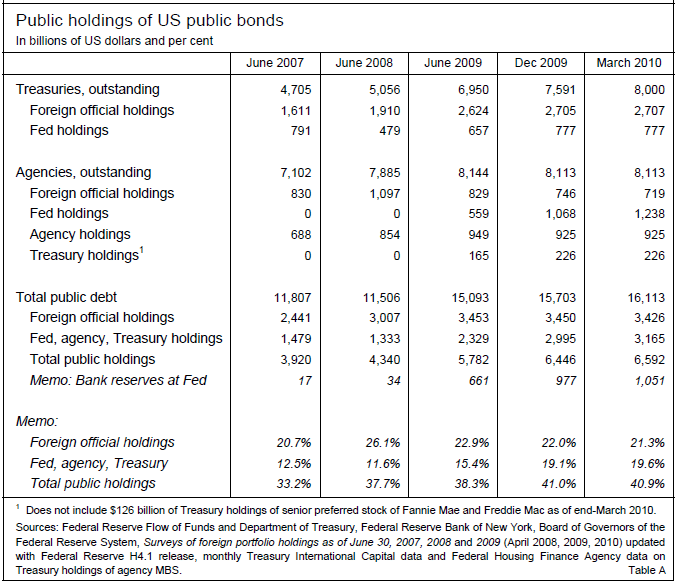Higher public-sector holdings of US public debt
(Extract from pages 12-13 of BIS Quarterly Review, June 2010)
The Federal Reserve smoothly ended its huge programme of bond purchases when it bought its last agency mortgage-backed bonds at the end of March 2010. Ending purchases does not imply, though, that holdings no longer help keep bond yields low. Gagnon et al (2010)1 argue that the impact depends on the stock of Federal Reserve holdings of US Treasury and agency ("public") debt, rather than on the flow of purchases. In that spirit, public debt holdings by sovereign asset managers outside the United States could have a similar impact on yields. Taken together, US government bodies and foreign official portfolios hold more than 40% of Treasury and agency securities, and they have probably absorbed over half of the net supply since mid-2008. On a duration-weighted basis, the increase has been even larger, which would amplify any impact on long-term yields.
To be sure, the motivations for the stepped-up official holdings have differed. For its part, the Federal Reserve, in conjunction with the US Treasury, has bought bonds in order to lower mortgage and other long-term yields to private borrowers. This policy interest is expected in time to abate and to reverse. Indeed, the minutes of the 27-28 April 2010 Federal Open Market Committee meeting reported majorities for a five-year bond sale programme and for timing sales after an eventual hike in the short-term policy rate. Foreign official holders have different motivations in holding US public debt and tend to behave differently over the interest rate cycle. They build up and run down their holdings of US public debt for a variety of reasons, including as a by-product of resisting currency appreciation and depreciation and as insurance against sudden calls for foreign exchange. While many central banks used their foreign exchange reserves during the crisis to support their currencies and to provide dollar liquidity to the private sector, foreign official holdings of US public debt securities reportedly rose in the years covered by the surveys of June 2008 and June 2009.
Overall, the share of US public debt held by officials has risen. Before the onset of the crisis, foreign officials and the Federal Reserve held between them about one third of US public debt securities, mostly Treasury securities. Since then, such public holdings have increased to more than 40%. The most striking development has been the increase in the share of US public debt held by the US public sector, which went up by 7 percentage points, to roughly 20%. The Federal Reserve's purchase of over $1.4 trillion in agency debt - mostly mortgage-backed securities - accounted for the bulk of this increase. By contrast, Federal Reserve holdings of Treasuries contributed little on balance over this period. The percentage share of foreign official institutions was roughly stable in the low 20% range, as a decline in holdings of agency securities appears to have been more than offset by larger holdings of US Treasury securities.2
The rise in the share of publicly owned US public debt understates the shift in terms of duration. The most recent survey of foreign official holdings of Treasuries shows that half mature in three years or less, with an average maturity of 48 months, slightly less than that of Treasury securities overall. Whereas traditionally the Federal Reserve had aimed for market neutrality in its Treasury holdings, in the recent bond buying, "the composition of purchases was tilted towards longer-maturity or longer-duration securities in order to enhance the portfolio balance effect and reduce longer-term interest rates" (Gagnon et al (2010, p 10)). In particular, Federal Reserve purchases of mortgage-backed securities focused on recent 4% and 4.5% paper of particularly long duration.
In sum, on the available evidence, large-scale US official purchases of agencies have raised the share of the rapidly growing US public debt in relatively concentrated public hands to more than two fifths.3 Much of the large increase in US public debt since 2008 has found its way into official hands.
1 J Gagnon, M Raskin, J Remaché and B Sack, "Large-scale asset purchases by the Federal Reserve: did they work?", Federal Reserve Bank of New York, Staff Reports 441, March 2010.
2 The table mostly relies on annual surveys of stocks, which drill down with custodians to identify foreign official holdings that monthly transactions data miss. In particular, the last surveys of June 2007, 2008 and 2009 raised the estimate of foreign official holdings by 13%, 5% and 17%, respectively. Thus the December 2009 and March 2010 estimates are likely to be understated.
3 One could view the US official purchases as entirely asset swaps, as were the Treasury purchases of agencies with the proceeds of sales of Treasury securities. Accordingly, one could include Federal Reserve liabilities to banks in the public debt (treating banks' claims on the Federal Reserve as close substitutes for their holdings of Treasury bills). In terms of the table, this would mean adding the memo item "Bank reserves at Fed" to the public debt. On this view, the increase in the US public debt would be larger since mid-2008 and the rise in the share in public hands somewhat smaller. Still, much of the large increase in US public debt would have found its way into official hands.


